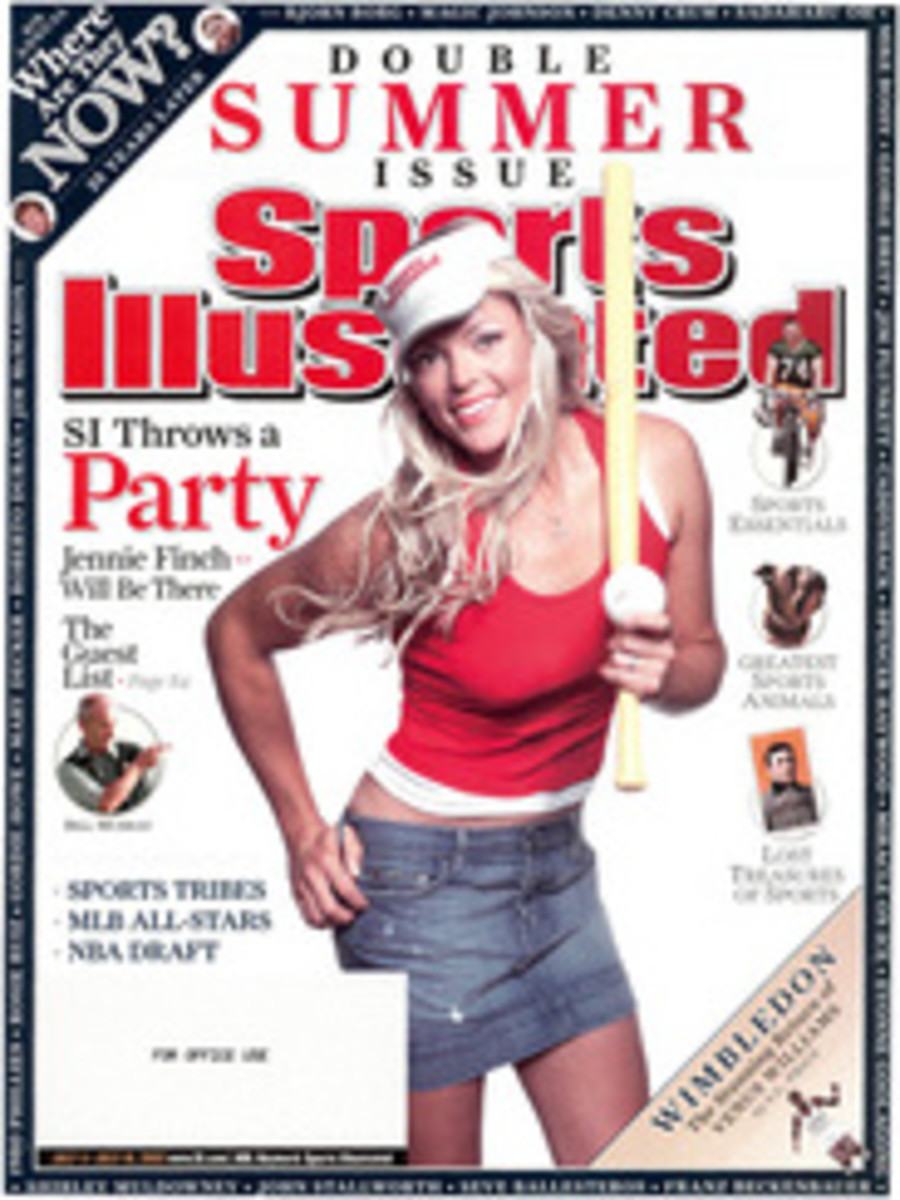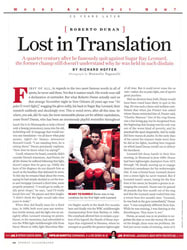
Lost in Translation
[ ROBERTO DURAN ]
A quarter century after he famously quit against Sugar Ray Leonard, the former champ still doesn't understand why he was held in such disdain
Cosell, whatever he heard, certainly didn't mistake Duran's intentions. And Duran, for all the shame he suffered following that fight, doesn't argue that he gave up. Oddly the facts of his disgrace do not disturb him as much as the headline that delivered its news. To this day he remains blasé about the event, saying he had simply decided to cut his losses and reengage Leonard a third time, more properly prepared. "I would get in really, really great shape," he says, "and I'd really knock him out." He pauses and then laughs. "I didn't think the fight would take nine years to make."
When they did finally meet for a third time, in 1989, both were past any motivation beside money, and the fight was an unsightly affair, Leonard winning on points. Duran, in the meantime, had rebounded to win the WBA light middleweight title from Davey Moore in 1983, fight Marvelous Marvin Hagler nearly to the death five months later and finally win the WBC middleweight championship from Iran Barkley in 1989. His comeback allowed him to reclaim a portion of his legend, the Hands of Stone mystique that originated in Panama, where he emerged as possibly the greatest lightweight of all time. But it could never erase the no màs--rather, the no peleo fight, one of sport's great puzzlers.
Had an election been held, Duran would have been voted least likely to quit in the ring. He was such a fierce and reckless combatant that when Joe Frazier was asked whom Duran reminded him of, Frazier said, "Charles Manson." Out of the ring Duran was a fun-loving guy, but he recognized from the beginning that boxing was his only way out of the worst kind of poverty, and he practiced the sport desperately. And he really did have manos de piedra. In the early days of his career his trainers made more than he did at his fights, hustling bets ringside on which hand Duran would use to deliver the knockout.
Leonard felt those hands in their first meeting, in Montreal in June 1980. Duran had been lightweight champion from 1972 through '78, finally moving up to engage America's sweetheart for his welterweight title. It was a brutal bout, Leonard drawn into a street fight he never wanted. But if Leonard wasn't smart, losing for the first time in his career, he became a genius in arranging the rematch. Duran says he gained 50 pounds that first month out of the ring and that the Leonard camp rushed him into a return bout five months later. "Leonard, he was back in the gym immediately," Duran says. "I was completely different from him. While he was training, I was dancing in the discotheques. They knew it, too."
Duran, as usual, was in no position to negotiate the date or even the money. He needed the dough; there were tax problems. He had just seven weeks of training, some of it in a rubber corset, the last days living on diuretics. He still says it was cramps, not that embarrassing left jab Leonard delivered in the seventh round after pretending to wind up for a bolo punch, that dictated the result. "Frustrated? No, that's how Leonard fights," he says, dismissing the armchair psychologists who claim he quit in protest over Leonard's insistence of style over substance. "My stomach was paralyzed." He even pulls up his shirt to show the location of his pain. Although he seems to be describing appendicitis, he believes it was the hot coffee he drank right before the fight, coming after he had purged (and then, following the weigh-in, gorged), that produced his distress.
Duran was amazed at the furor his retreat created. To him it was a good business decision; he wasn't going to win this fight, so he was saving himself for the next one. Yet in Panama he was mocked, called a chicken. Minus a third fight with Leonard, though, he didn't see a way to redeem himself, so he continued to train on the dance floor. He lost decisions to Wilfredo Benitez in January 1982 and, in a fight that was judged the upset of the year by The Ring magazine, to Kirkland Laing in September '82.
It wasn't until the summer of 1983, when, finally fit, Duran upset Moore to become the WBA light middleweight champion, that he could be taken seriously again. Six years later, at the age of 37, he surprised once more, beating Barkley for the WBC middleweight crown. Lightweight to middleweight, champion all the way. Back in Panama City fans lined the streets to welcome their old hero.
It is now possible to laugh at the idea of Duran as a quitter. He fought until the age of 50 and retired only because of injuries sustained in a serious car accident in Buenos Aires. Now, at age 54, he still wishes he were in the ring. "I would have no problem with the young guys today," he says. "None."
That said, Duran seems to enjoy life outside the ring, dabbling with salsa groups he hopes to get off the ground--"I've spent three to four million dollars on music," he says, shrugging comically. He also goes to Europe for autograph shows and assists Luis de Cubas, his former manager, with Team Freedom Promotions, a Florida-based outfit that stages cards around the country. "I am never home," Duran says, although he often travels with his family; he has eight children and has been married to his wife, Felicidad, for 33 years. He would like to do a book about his life, and maybe a movie, although he thinks, as with the 1980 Leonard fights, there would have to be two of them. "One where you laugh," he says, "one where you cry."
A big part of his job seems to be nurturing the legend of Roberto Duran. The complicated story of a poor boy who always took the first 60 cents he made at his shoeshine stand to light six candles and who became the fiercest fighter of his time hardly needs burnishing, but Duran will gladly give it a buff. For example, the story of his decking a horse. There are several accounts that Duran, drunk in a bar after celebrating an early victory, was dared to fight a horse. Now which was it? he's asked. Was the bet for a bottle of whiskey or for $200? Duran realizes his history could use some attention. He thinks for a minute. "Both," he finally says, and proceeds to reenact the entire event--it's practically a cabaret act--with a hilarious attention to detail, incorporating every possible version of the anecdote.
In any case, he points out, the horse did go down. Nobody's ever disputed that.
>>> JAN. 9 SERGIO GARCíA BORN. POPULAR HAIRSTYLE CORNROWS, A LA BO DEREK IN 10 JAN. 19 MICHAEL JACKSON'S ROCK WITH YOU HITS NO. 1. >>> >>> FEB. 2 REPORTS SURFACE THAT FBI IS TARGETING MEMBERS OF CONGRESS IN ABSCAM STING OPERATION. AVERAGE COST OF MOVIE TICKET $2.69 >>>
COLOR PHOTO
MANNY MILLAN
READY TO RUMBLE
Duran was in top condition for his first fight with Leonard.
COLOR PHOTO
A DIFFERENT DRUM
Music has been a part of Duran's life since he survived a serious car accident and retired at age 50.
COLOR PHOTO
JOHN BIEVER (GARCIA)
COLOR PHOTO
SONY (JACKSON)
COLOR PHOTO
CORBIS (POPCORN)

